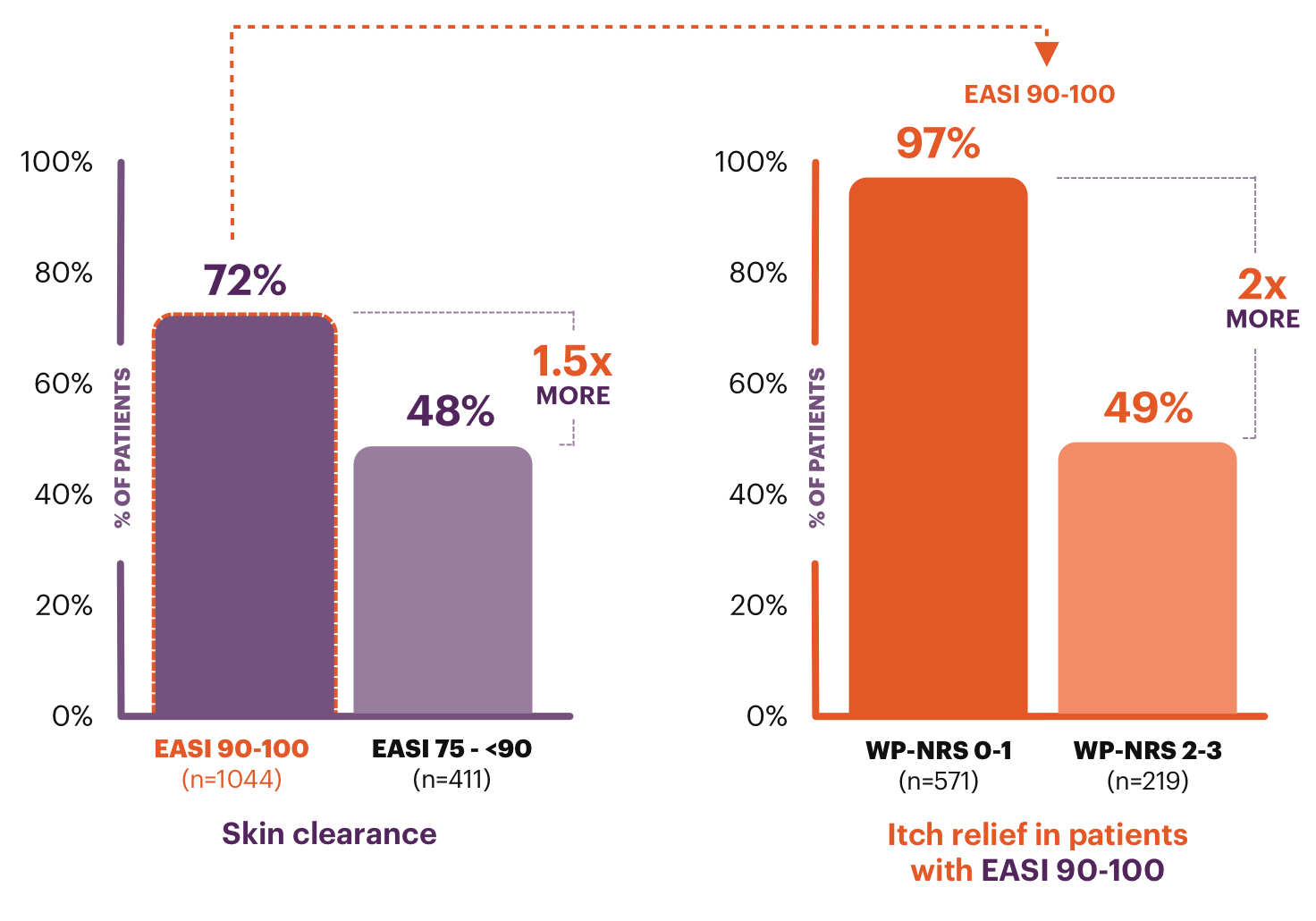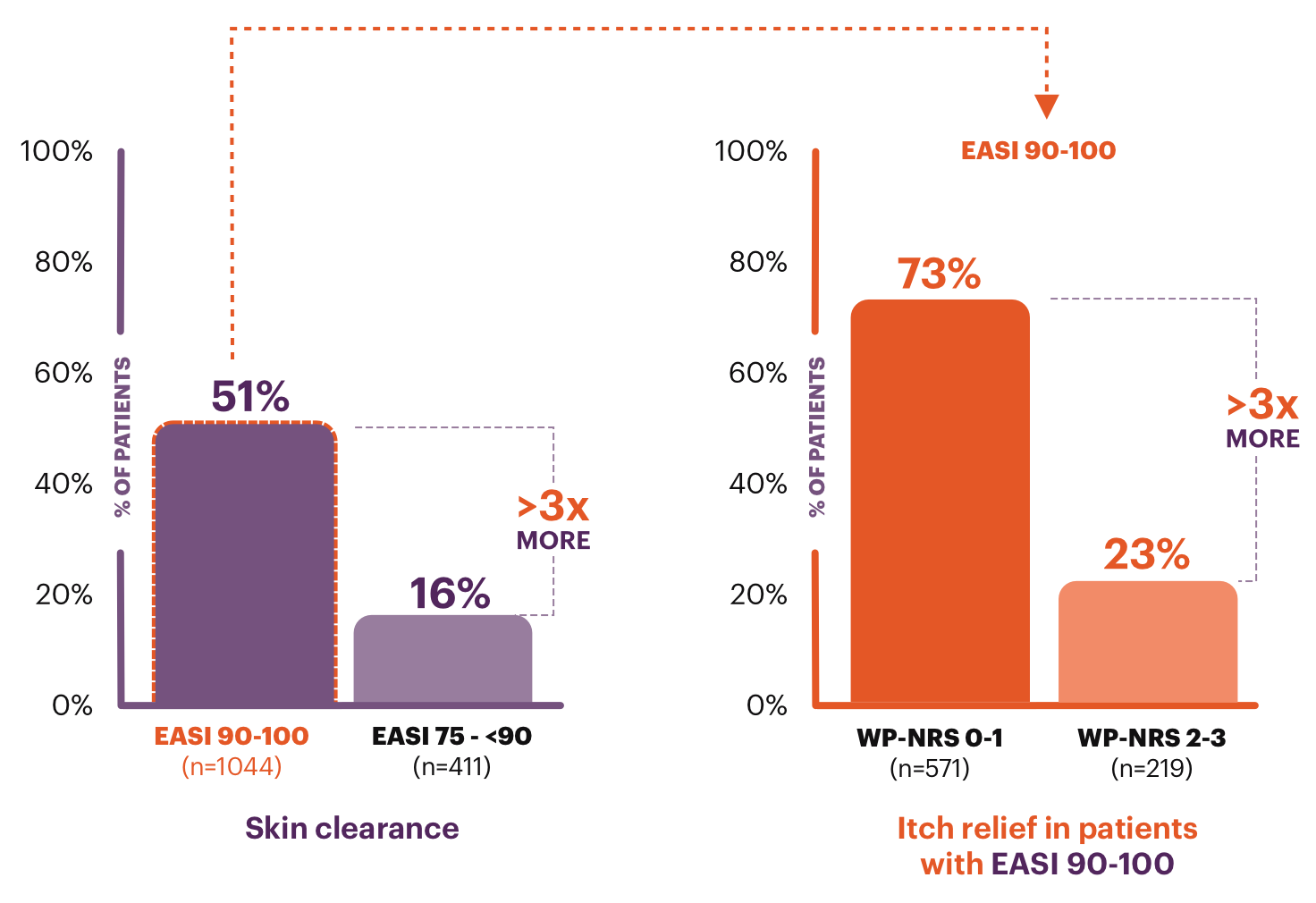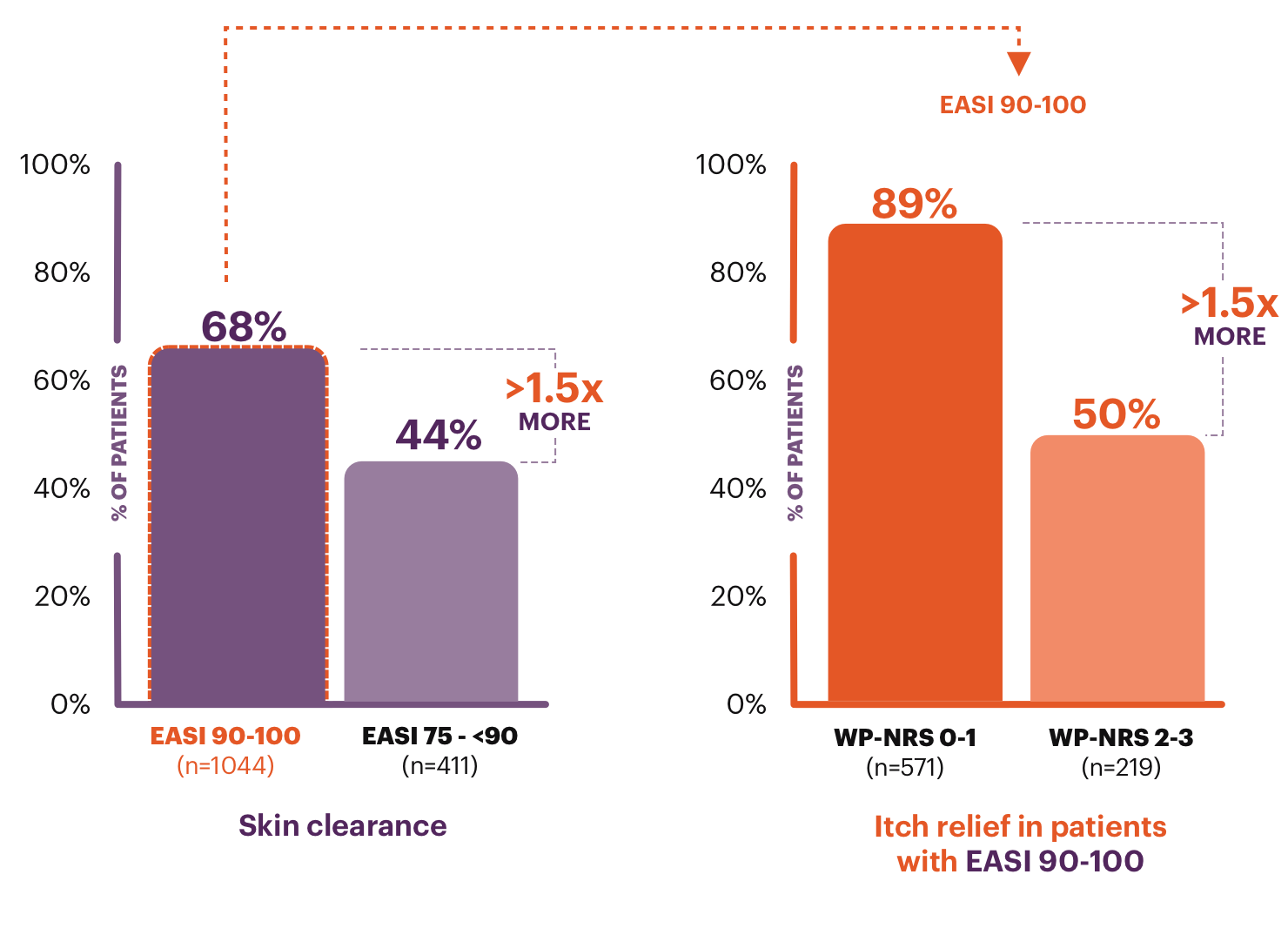WP-NRS 0-1
No to little itch2
Patient-Reported Outcomes
The voice of the atopic dermatitis (AD) patient is important in determining their true disease burden
Improved sleep scores were observed with less itch and clearer skin1,2
Even with 90%-100% clearer skin, itch can still impact an AD patient's sleep scores1,2*
Proportion of patients achieving ideal state sleep scores (0-3) at Week 16.† Post hoc, integrated analysis of observed cases.

*Domain scores for sleep and emotional state calculated as part of ADerm-IS.
†Data include patients from three phase 3 studies at Week 16 in placebo and treatment groups.
Limitations1
- These are descriptive, observational, post hoc analyses; no statistical significance or conclusions can be drawn from these analyses
- These PROs used questionnaires to ask patients to self-report their symptoms and impact in relation to their AD; factors not included in these PROs or not directly related to AD may confound these results
- EASI data excludes 937 patients who did not achieve EASI 75 and WP-NRS data excludes 166 patients with WP-NRS ≥4
Calculations of the percent of patients achieving response were based on available data for each outcome. Sample sizes may vary depending on data availability of the measures involved.
Ask your patients how their disease is truly impacting them
It's important to look beyond rash alone. Itch may also impact your patients' sleep, DLQI, and emotional state scores.1
Clearer skin alone may not be enough


EASI 90-100
Almost clear to clear skin4
Improved DLQI scores were observed with less itch and clearer skin1,2
Even with 90%-100% clearer skin, itch can still impact an AD patient's quality of life1,2*
Proportion of patients achieving ideal state DLQI scores (0-1) at Week 16.* Post hoc, integrated analysis of observed cases.

*Data include patients from three phase 3 studies at Week 16 in placebo and treatment groups.
Limitations1
- These are descriptive, observational, post hoc analyses; no statistical significance or conclusions can be drawn from these analyses
- These PROs used questionnaires to ask patients to self-report their symptoms and impact in relation to their AD; factors not included in these PROs or not directly related to AD may confound these results
- EASI data excludes 937 patients who did not achieve EASI 75 and WP-NRS data excludes 166 patients with WP-NRS ≥4
Calculations of the percent of patients achieving response were based on available data for each outcome. Sample sizes may vary depending on data availability of the measures involved.
Ask your patients how their disease is truly impacting them
It's important to look beyond rash alone. Itch may also impact your patients' sleep, DLQI, and emotional state scores.1
Clearer skin alone may not be enough

WP-NRS 0-1
No to little itch2

EASI 90-100
Almost clear to clear skin4
Improved emotional state scores were observed with less itch and clearer skin1,2
Even with 90%-100% clearer skin, itch can still impact an AD patient's emotional scores1,2*
Proportion of patients achieving ideal state emotional state scores (0-2) at Week 16.† Post hoc, integrated analysis of observed cases.

*Domain scores for sleep and emotional state calculated as part of ADerm-IS.
†Data include patients from three phase 3 studies at Week 16 in placebo and treatment groups.
Limitations1
- These are descriptive, observational, post hoc analyses; no statistical significance or conclusions can be drawn from these analyses
- These PROs used questionnaires to ask patients to self-report their symptoms and impact in relation to their AD; factors not included in these PROs or not directly related to AD may confound these results
- EASI data excludes 937 patients who did not achieve EASI 75 and WP-NRS data excludes 166 patients with WP-NRS ≥4
Calculations of the percent of patients achieving response were based on available data for each outcome. Sample sizes may vary depending on data availability of the measures involved.
Ask your patients how their disease is truly impacting them
It's important to look beyond rash alone. Itch may also impact your patients' sleep, DLQI, and emotional state scores.1
Clearer skin alone may not be enough

WP-NRS 0-1
No to little itch2

EASI 90-100
Almost clear to clear skin4

Explore additional PRO data on the role of itch resolution and skin clearance in AD and quality of life by Target RWE.
Hear how Dr. Seminara assesses AD among her patients
Dr. Seminara discusses the importance of thoroughly assessing AD patients’ symptoms (even if they seem under control) and having experiences interacting with family and patients with AD. There are many challenges to assessing AD.
“When I’m assessing itch, sometimes it’s very obvious, but sometimes it’s much less obvious. If they’re experiencing persistent itch, even if they’re on systemic therapy, their disease may not be well controlled.”
– Dr. Seminara
Starting the conversation about symptom control
Even if your patients are showing skin clearance, it's important to ask if AD is affecting them in ways that aren't readily visible. See how addressing the complexity of AD and its many pathways can make a difference for your patients who are itching for change.
When it comes to their symptoms, some AD patients may not realize control is possible. Now is the time to discuss all the treatment options currently available to see which is right for them.
ADerm-IS=Atopic Dermatitis Impact Scale; ADerm-SS=Atopic Dermatitis Symptom Scale; DLQI=Dermatology Life Quality Index; EASI=Eczema Area and Severity Index; ITT=intention to treat; OC=observed cases; RWE=real-world evidence; TCS=topical corticosteroid; WP-NRS=Worst Pruritus Numerical Rating Scale.
REFERENCES:
- Data on File. ABVRRTI75191.
- Silverberg JI, Simpson EL, Calimlim BM, et al. Determining severity strata for three atopic dermatitis patient-reported outcome questionnaires: defining severity score ranges for the Worst Pruritus Numerical Rating Scale and the Atopic Dermatitis Symptom and Impact Scales (ADerm-SS and ADerm-IS). Dermatol Ther (Heidelb). 2022;12(12):2817-2827. doi:10.1007/s13555-022-00836-5
- Guttman-Yassky E, Teixeira HD, Simpson EL, et al. Once-daily upadacitinib versus placebo in adolescents and adults with moderate-to-severe atopic dermatitis (Measure Up 1 and Measure Up 2): results from two replicate double-blind, randomised controlled phase 3 trials. Lancet. 2021;397(10290):2151-2168. doi:10.1016/S0140-6736(21)00588-2
- Reich K, Teixeira HD, de Bruin-Weller M, et al. Safety and efficacy of upadacitinib in combination with topical corticosteroids in adolescents and adults with moderate-to-severe atopic dermatitis (AD Up): results from a randomised, double-blind, placebo-controlled, phase 3 trial. Lancet. 2021;397(10290):2169-2181. doi:10.1016/S0140-6736(21)00589-4
- Silverberg JI, Thyssen JP, Costanzo A, et al. The multidimensional burden of moderate to severe atopic dermatitis: a pooled analysis of baseline data from three phase 3 studies (Measure Up 1, Measure Up 2, and AD Up). Poster presented at: 2021 Revolutionizing Atopic Dermatitis (RAD) Virtual Conference; June 13, 2021.
- Hongbo Y, Thomas CL, Harrison MA, Salek MS, Finlay AY. Translating the science of quality of life into practice: what do Dermatology Life Quality Index scores mean? J Invest Dermatol. 2005;125(4):659-664. doi:10.1111/j.0022-202X.2005.23621.x

